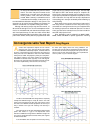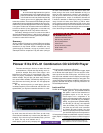
ter or a motion-adaptive 3-D comb filter when using the
composite input.
Performance
My overwhelming first impression of the Sony G90 was its
razor-sharp image clarity. The 9-inch CRT technology reveals
the resolution limits of projectors with smaller CRTs. I sup-
pose it was even more impressive that the first things I looked
at were HDTV pictures. But the differences in detail between
the Sony G90 and the excellent but smaller CRTs of the Runco
IDP-980 Ultra, were also noticeable on DVD. Edges were a tad
sharper and areas of fine structure appeared to have addi-
tional depth and contrast.
The G90 has an outstanding ability to differentiate subtle
levels of dark gray just above black. Plus there is virtually no
shift in black level with changes in average picture level
(APL). I confirmed this using the various PLUGE test patterns
provided by the Video Essentials DVD in title 17, chapters 2,
3, 5, and 7. The Video Montage sequence from this same DVD
showed how effectively the G90 held black levels constant to
increase contrast-ratio and reveal shadow details.
I was able to adjust the grayscale color temperature to
exceptional accuracy, 6500K +300/-50K at 7.75 ft-L measured
at the plane of my 1.3 gain screen, which equates to about 10
ft-L for on-axis viewing. The G90 provides a gamma adjust-
ment for individual CRTs that is found on few other projec-
tors. It enables better tracking of the three CRTs and a flatter
grayscale response. I believe I could have improved the
grayscale even further had I had more time. Without even re-
calibrating, I cranked up the light output at the screen plane
to over 14 ft-L and the color temperature only dropped to
6100K. So the projector is capable of much higher light output
than I used for comparison tests.
Despite the excellent grayscale results, I was less
pleased with the color accuracy. The primary reason (pun
intended) was the chromaticity of the green phosphor. It is
somewhat more yellow than the SMPTE C standard green.
(See measurements.) This eliminated the deepest green hues
from the color gamut, slightly desaturated the blue-greens
(cyan), and shifted the purple hues (magenta) toward blue.
The yellower-green can be seen in landscapes and fields
where greener pastures are expected. Skin-tones appeared
slightly pale or colder than normal. If the color temperature
is calibrated slightly more red than normal, the skin-tones
will be corrected and magenta much improved. I found that
a more pleasing picture.
The green phosphor may have been a deliberate choice to
maximize the light output of the projector. The G90 is rated at
1300 peak lumens and 350 ANSI lumens, impressive specs for
a CRT projector. In my testing, the G90 luminance dropped
only 2 percent when going from a small white window to a full
screen of peak white. That is amazing performance and
reflects its superior full-white rating of 500 lumens. The pic-
ture simply won’t dim on the brightest scenes. The white field
uniformity was also exceptional with very little variance in
brightness or color over the screen.
Fan noise on the G90 wasn’t nearly as loud as might be
expected from a projector drawing 1050 watts. I measured 51
dB “C” weighted, at three feet from the unit. The fan noise is
not high-pitched, but has a rushing-air sound that is often
masked by the music and dialog in a movie. It may be accept-
able in a ceiling-mount application without additional attenu-
ation, but I wasn’t able to experience that.
The Sony G90 includes a built-in video
upconverter that converts NTSC formats from
480i (active lines) to 960i interlaced video. Sony
calls its process Digital Reality Creation, or DRC.
It uses pattern matching in look-up tables to do
the conversion. Conventional line doublers or quadruplers
use entirely different processes to create 480p and 960p pro-
gressive video. I used the DRC to watch live basketball games
and DVD movies. Video-camera sources, like the basketball
game, will create some artifacts on any type of upconverter. I
found the artifacts on Sony’s unique DRC system to look more
artificial, dare I say digital, than other techniques. Artifacts
sometimes have a pixellated appearance. It comes down to
matter of preference, but I’m more accustomed and comfort-
able with the twitter artifacts of conventional line-doublers
and quadruplers. On movies the DRC did a better job but
couldn’t match the complete absence of deinterlacing arti-
facts from upconverters that use inverse-telecine processing.
But the DRC feature is included standard with the G90 and a
high-quality quadrupler will approach $20,000.
I used PBS broadcasts to evaluate HDTV on the G90. This
was where it really excelled. Projectors without 9-inch CRTs
simply don’t have enough resolution to fully display the hori-
zontal and static vertical resolution of 1080i signals. The G90
has what it takes. HDTV on 7- and 8-inch CRT projectors like
the Runco DTV-930 can look wonderful, but on the G90 the
picture achieves an astonishing clarity. PBS has many air-
borne sequences flying across agricultural and urban land-
scapes that are so clear that you will feel like you are actual-
ly skimming the tree tops and peering into office building win-
dows. A ride in a raft down the mighty Colorado river may
convince you that it might be better to watch on the G90 than
to actual participate. After sitting glued to my chair watching
this HDTV demo material several times for more than hour, I
can sing praises about the HDTV format and the incredible
resolution and 3-dimensionality of the G90 picture. It rivals
the best film presentations that I have seen at a well-main-
tained cinema. Sadly, few people will actually get to enjoy this
experience.
Summary
The Sony VPH-G90U will produce stunning picture resolution,
surpassing the definition, contrast, and image depth of 8” or
smaller CRT projectors. It is one of the very few CRT projec-
tors, or display devices of any kind, capable of producing
HDTV’s available resolution. Audition it when you are select-
ing from among the ultimate home-theater projectors.
SONY VPH-G90U MULTISCAN PROJECTOR
Sony Electronics Inc
1 Sony Drive
Park Ridge, New Jersey 07656
Phone: (201) 930-1000
www.sony.com
Source: Manufacturer Loan
S/N: 2000039
Price: $35,000
M a n u f a c t u r e r I n f o r m a t i o n


















